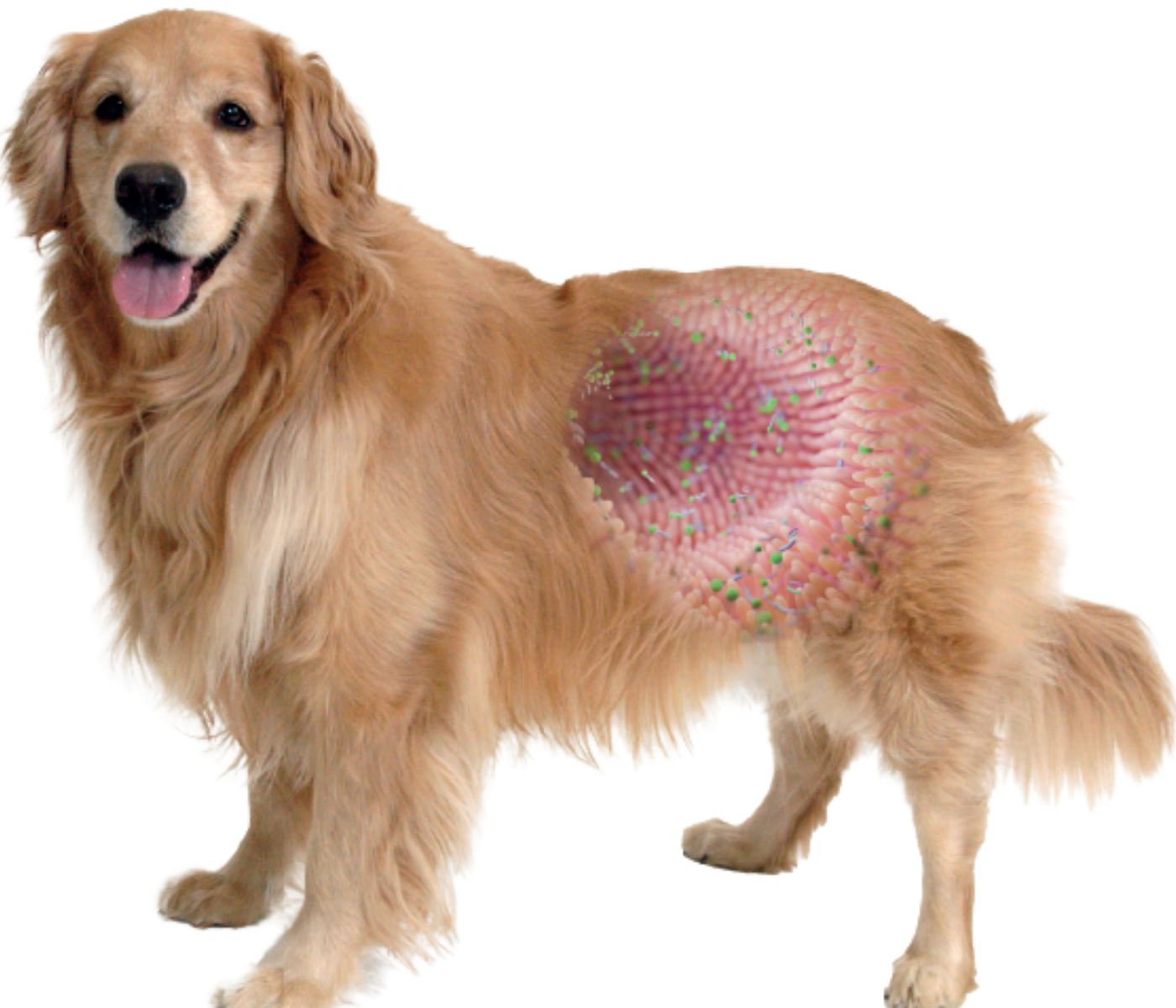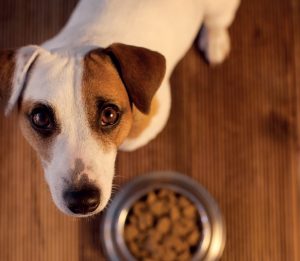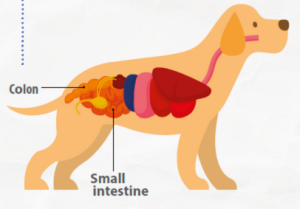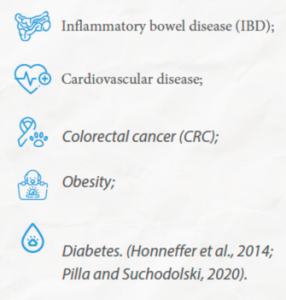Fiber and its influence on the intestinal function of dogs
Adequate intestinal function depends on the gut microbiota, which is essential for nutrient metabolism and absorption. As well as for the correct assimilation of other compounds consumed by small animals. A healthy microbiota is characterized by a delicately balanced high diversity of microbial genera. Which in turn confers the animal an increased metabolic capacity within the intestine.
The population dynamics of gut microbiota can be altered by factors such as:
- Age;
- Nutrition;
- Stress;
- Bacterial infectious diseases;
- Hygiene;
- Consumption of pre and probiotics.
The composition of macronutrients and the addition of some specific ingredients in the diet can help modulate the microbiota and its metabolites, which benefits dogs’ overall health.
Among the various compounds that can act as modulators of the microbiota, the immune system and the intestinal integrity of dogs, fiber stands out.
Dietary fiber includes polysaccharides and other substances associated with the cell wall of plants. These compounds are resistant to the action of mammal digestive enzymes due to the presence of β-type bonds (Van Soest, 1994).

Although these fibers a not digestible by the animal’s own enzymes, dogs contain certain microorganisms that are capable of fermenting fiber. This type of fermentation produces metabolites that contribute towards beneficial physiological changes, disease prevention as well as generating alternative energy sources for cells of the intestinal mucosa. This phenomenon is especially notorious within the colon.
It is worth noting that the fermentation of dietary fiber is more variable than the digestion of other macronutrients like: starch, fat and protein. This variation is mainly due to changes in the physicochemical properties of fiber. Including:
- Volume;
- Viscosity;
- Solubility;
- Water retention capacity;
- Degree of fermentability.
Fiber in dog diets
The use of fiber in dog diets has been questioned mainly due to the lack of knowledge regarding its nutritional function and by the fact that this species lacks the enzymes to digest these compounds.

However,new research has shed light on the importance of fiber and its role within dog nutrition. Associating its inclusion with positive effects in: intestinal transit regulation, maintaining intestinal integrity and function, as well as in the modulation of gut microbiota.
Studies have shown that these compounds are also capable of influencing: fecal consistency, dilution of food energy, appetite regulation and satiety in dogs, thanks to their physicochemical properties(Bosch et al., 2009; Sabchuk et al., 2017).
Effects of fiber on the intestinal environment
The susceptibility of dietary fiber to microbial fermentation varies according to its availability and the acces that microbial populations in the gut have to it. In monogastric animals, as is the case of dogs, the large intestine represents the main fermentation site for these types of compounds. Fermentation of the soluble fraction of fiber primarily takes place in the proximal colon, while fermentation of the insoluble fraction continues up until the distal colon.

Generally speaking, fiber fermentation is an extremely complex process, affected by many factors in the gastrointestinal tract. Including the host, its microbiota, and the interaction that occurs between them.
 In general, dietary fiber fermentation results in the production of short-chain fatty acids (SCFA, Figure 1) such as: acetate, propionate, and butyrate. As well producing other gases like hydrogen and carbon dioxide.
In general, dietary fiber fermentation results in the production of short-chain fatty acids (SCFA, Figure 1) such as: acetate, propionate, and butyrate. As well producing other gases like hydrogen and carbon dioxide.
SCFAs are the main end products of the colonic bacterial fermentation of unabsorbed starch and non-starchy polysaccharides. These in turn are the main organic anions present in colonic content (Bugaut, 1987).
On the other hand, branched-chain fatty acids (BCFAs), i.e., isobutyrate and isovalerate, result from the degradation of proteins by bacteria with pathogenic potential. In addition to SCFAs, other metabolites such as lactate, ethanol, and succinate are also produced through the bacterial fermentation of fiber.

SCFAs are readily absorbed by the intestinal epithelium through passive diffusion and are used to favor bacterial growth. Although SCFAs are mainly absorbed and metabolized by intestinal cells, they are also used as a energy sources by other tissues, including: intestine, liver and muscle.
In addition, the absorption of SCFA stimulates the reabsorption of water and electrolytes. This links them to the intestine’s osmoregulatory function, and influences fecal humidity levels.
The presence of SCFA stimulates the secretion of glucagon like-peptide 2, an enteric hormone, which drives cell differentiation and proliferation and the expression of certain genes that are associated with the transport of nutrients in the ileum. This leads to and enhanced digestive function.
- In addition, mucosal growth also improves its barrier function, reducing permeability and the subsequent translocation of microorganisms (NRC, 2006).

It’s worth highlighting that the extent of fermentation and SCFAs profiles, depend on the substrate, while the fermentation rate of fiber depends on its composition, physicochemical properties, degree of lignification, particle size and transit time within the digestive tract. Thus, these characteristics directly depend on the botanical origin, as well as on the processing and particle size of the fiber source.
Fiber can also influence bacterial populations and activity within the gut. As it has an influence on the conditions in which intestinal microbiota develops(Brito et al., 2021). In addition to representing an energy source for colonocytes and stimulating the growth and metabolism of non-pathogenic bacteria, fiber contributes to reducing luminal pH. This creates an unfavorable environment for the growth and development of potentially pathogenic bacteria, such as Clostridium difficile and E. coli.

These microorganisms perform microbial fermentation of endogenous and/or undigested nitrogenous compounds, such as ammonia, biogenic amines,and BCFAs. This results in the formation of putrefactive substances, responsible for the bad odor in feces, which is an undesirable effect by dog owners. Many of these putrefactive compounds, exert an adverse effects on intestinal health besides causing bad odors. Some examples of these de deleterious impacts are: increased permeability, dysbiosis, and enteritis.
Hence,in addition to providing a balanced diet with highly digestible proteins, the dietary inclusion of fiber can contribute to reducing the formation of putrefactive compounds in the colon of dogs.
Some genera such as Faecalibacterium spp., Blautia spp., Turicibacter spp., and Fusobacterium spp. are considered as “sentinel” bacteria. This is due to the fact that they are sensitive to changes in intestinal homeostasis and become significantly reduced in gastrointestinal diseases (Alshawaqfeh et al ., 2017; Felix et al., 2022). Most of these genera are associated with dietary fiber digestion and SCFA production.
In addition, their metabolites exert anti-inflammatory effects on the intestinal mucosa. Fiber intake has also been shown to reduce the risk of many metabolic and inflammatory pathologies:

Another interesting effect associated with fiber intake, is the potential modulation of gastrointestinal motility. Considering the fact that secondary bile salts and SCFAs produced in bacterial fermentation, can stimulate contractions of intestinal circular smooth muscle (Eswaran et al., 2013).

In addition, increased dietary fiber intake can promote satiety. It has been found that diets with high fiber inclusion can increase satiety in dogs. This can probably be explained by gastric distension and the release of cholecystokinin(CCK) (Weber et al., 2007). As a result, gastric and intestinal distension stimulate the vagus nerve, and emit satiety signals.

There is also evidence that the inclusion of high concentrations of fiber, increases mucin production within the intestine. Mucin plays a role in preserving immunity, as it helps prevent the translocation and adherence of pathogenic bacteria to the intestinal mucosa. Therefore, it indirectly modulates the intestinal microbiota (Saqui-Salces et al., 2017).
Final considerations
It can be said that the presence of dietary fiber in dog diets significantly influences the intestinal microbial environment. Providing favorable lumen conditions, stimulating the growth of commensal microorganisms and boosting the production of metabolites associated with good intestinal function. On the other hand, the effects of dietary fiber on intestinal function vary according to its physicochemical properties.
You may also like to read: “Functional pet foods: What are they?”

Bibliographical References:
ALSHAWAQFEH, M. K. et al. A dysbiosis index to assess microbial changes in fecal samples of dogs with chronic inflammatory enteropathy. FEMS Microbiology Ecology, v. 93, n. 136, 2017.
BOSCH, G. et al. The effects of dietary fibre type on satiety-related hormones and voluntary food intake in dogs. British Journal of Nutrition, v. 102, n. 2, p. 318-325, 2009.
BRITO, C. B. M. et. al. Effect of dietary inclusion of dried apple pomace on faecal butyrate concentration and modulation of gut microbiota in dogs. Archives Animal Nutrition, v. 75, n. 1, p. 48-63, 2021.
BUGAUT, M. Occurrence, absorption, and metabolism of short chain fatty acids in the digestive tract of mammals. Comparative Biochemistry and Physiology Part B: Comparative Biochemistry, v. 86, n. 3, p. 439-472, 1987
ESWARAN, S. et al. Fiber and functional gastrointestinal disorders. Official Journal of the American College of Gastroenterology, v. 108, n. 5, p. 718-727, 2013
FÉLIX, A. P. et al. Biomarkers of gastrointestinal functionality in dogs: A systematic review and meta-analysis. Animal Feed Science and Technology, p. 115183, 932 2022.
HONNEFFER, J. B. et al. Microbiota alterations in acute and chronic gastrointestinal inflammation of cats and dogs. World Journal of Gastroenterology, v. 20, p. 970 16489, 2014.
NRC. National Research Council. Nutrient Requirements of Dogs and Cats (Revised ed.). Washington (DC): NRC, National Academy Press, 2006.
PILLA, R.; SUCHODOLSKI, J. S. The Role of the Canine Gut Microbiome and Metabolome in Health and Gastrointestinal Disease. Frontiers in Veterinary Science, v. 6, p. 498, 2020.
SABCHUK, T. T. et al. Effect of soya hulls on diet digestibility, palatability, and intestinal gas production in dogs. Animal Feed Science Technology, v. 225, p. 134-1121 142, 2017.
SAQUI-SALCES, M. et al. Modulation of intestinal cell differentiation in growing pigs is dependent on the fiber source in the diet. Journal of Animal Science, v. 95, n. 3, 1132 p. 1179-1190, 2017
VAN SOEST, P. J. Nutritional ecology of the ruminant: ruminant metabolism, nutritional strategies, the celullolytic fermentation and the chemistry of forages and plant fiber. Ithaca: Cornell University Press, 1994.












